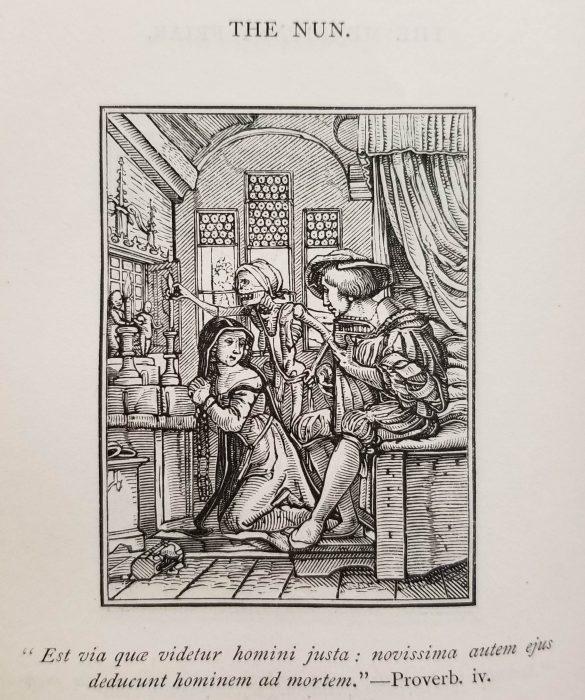These images are from a printed collection of woodcarvings designed by the famous Hans Holbein the Younger and carved by Hans Lutzelburger. By chance, I encountered a copy of Dance of Death in the Special Collections of the Burke Library — where I am currently working on Archives-processing projects as a student at Union Theological Seminary — and this unique volume opened my eyes to the world of Holbein’s woodcarvings.



Holbien was a 16th century German artist and printmaker who, over the course of his life, did work for Erasmus, Thomas More, Anne Boleyn, Henry VIII, and Thomas Cromwell. After working for More—who resigned over Henry’s desire to divorce his first wife, Catherine of Aragon—Holbein began to work directly for Anne Boleyn, More’s political and theological rival. Holbein was able to weather Anne’s famous downfall and in 1536, the year of her execution, he was officially employed as the King’s Painter. He went on to paint Henry, his third wife Jane Seymour, their child Edward, and many different courtiers. Holbein was also working for Cromwell during this time, creating images for Cromwell’s reformist, anti-clerical agenda. Following Jane’s death, Holbein returned to Germany under commission to paint Anne of Cleaves, the woman Cromwell was promoting as Henry’s next wife. As history has it, Holbein’s picture was highly flattering and Henry, distraught that his wife’s true face did not match Holbein’s picture, divorced Anne and beheaded Cromwell. Is it surprising then that a man who had witnessed and survived some of the most famous intrigues and downfalls in western history, would take as his subject, the fleeting nature of life and the constant, smiling certainty of death?
The images in this book depict the Dance of Death, or Dance Macabre, as drawn by Holbein. Dance of Death imagery was popularized long before Holbein, appearing in churches, monasteries, and illuminated manuscripts in the European Middle Ages. Ecclesiastically, Dance of Death imagery—people from all stations and ages confronted and called away by the personification of death as a skeleton—functioned as an allegory urging Christians to repent in the face of certain and, in those days, likely immanent death. Yet, as the essays in this 1858 book by Francis Douce demonstrate, the use of skeletons and stories of dancing death have much longer histories and more complex meanings. Douce tells how, according to Herodotus (a 5th century BCE historian), at Egyptian banquets, a dead body was brought out and presented to all the guests while the hosts proclaimed “Behold this image of what yourselves will be; eat and drink therefore, and be happy” (Douce, 2). Later Romans apparently adopted this tradition at their feasts (Ibid., 3). Thus the face of death can be used to call sinners to the church or diners to revelry. This ambiguity is somewhat captured in the once popular stories Douce recounts in which, though the characters and locations alter in every retelling, some group of people are loudly singing and dancing in direct defiance and mockery of priests, who are trying to conduct a religious service. The priest then asks God to force these dancers to continue their dance without stop for a year. God grants this request and the dancers gradually die, starved and exhausted, dancing themselves to death.
Holbein’s woodcarvings seem, to me, located within the space between allegory and ambiguity. Some of the images appear to clearly chastise immoral or corrupt behavior, such as the Judge, who is called by death as he prepares to take a bribe from a from a rich man, or the Advocate, which is similar. Yet others, such as the Husbandman, the Child, and the Abbess, illustrate that death comes for us all, regardless of virtue, age, or hard work. What then is the point of placing an image death before the unjust, as if in punishment, if later images demonstrate the unsettling and incontrovertible fact that death has little to do with justice? Sadly, these woodcarvings, exquisitely crafted and famous though they may be, do no more to answer that question than the mountains of philosophy and theology that came before and since. Therefore, in lieu of an answer to this question, I will leave you with my favorite image from the set: the Nun, kneeling in prayer, yet still able to cast flirtatious glances over her shoulder at the lute player in her room. Though this image was perhaps meant as a warning or a satire against the Catholic Church, I see it as the perfect marriage between the ancient Egyptian and European Middle Ages imageries of death. If life is fleeting and uncertain, why choose between prayer and merriment? Get it, girl.
